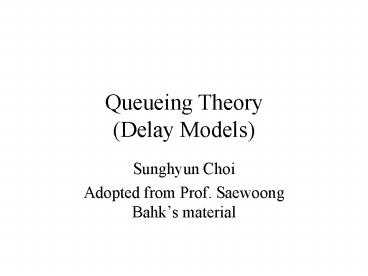Queueing Theory Delay Models PowerPoint PPT Presentation
Title: Queueing Theory Delay Models
1
Queueing Theory (Delay Models)
- Sunghyun Choi
- Adopted from Prof. Saewoong Bahks material
2
Time Reversibility - Burkes theorem
- Birth-death process Markov chain with integer
states in that transitions occur only between
neighboring states - Consider a discrete-time Markov chain Xn, Xn1 ,
3
4
- The backward transition probability
- If for all i,j the chain is time
reversible!!!
5
- Properties of the reversed chain (discrete time)
- (P1) Irreducible, aperiodic, the same stationary
distribution as the forward chain - Proof
6
- (P2) If there are pi s.t.
- form a transition prob. matrix, i.e.,
, - then pi is the stationary distribution and
- are the transition prob. of reversed
chain. - Proof
7
- (P3) A chain is time reversible iff
- (P1) (P2) hold even if chain is not time
reversible! - Birth-death process (e.g., M/M/1, M/M/m, etc.)
are time reversible
8
- For irreducible CTMC
- (P1) The same stationary distribution as the
forward chain with - (P3) The forward chain is time reversible iff
- (detailed balance eq.)
9
- (P2) If there are pi s.t. and
- then pi is the stationary distribution and
- are the transition rates of reversed
chain. - Proof
10
time reversible chain
Non-time reversible chain
11
In steady-state, forward and reverse systems are
statistically indistinguishable!
12
- Burkes theorem Consider an M/M/1, M/M/m, M/M/8
system with arrival rate ?. Suppose that the
system starts in steady-state. Then the following
is true - The departure process is Poisson with rate ?.
- At each time t, the number of customers in the
system is independent of the sequence of
departure times prior to t.
13
EX) Two M/M/1 queues in tandem
- - Poisson arrival and exp. service time
- - Assume that the service times of a customer at
1st and 2nd queues are mutually independent and
independent of arrival process.
PowerShow.com is a leading presentation sharing website. It has millions of presentations already uploaded and available with 1,000s more being uploaded by its users every day. Whatever your area of interest, here you’ll be able to find and view presentations you’ll love and possibly download. And, best of all, it is completely free and easy to use.
You might even have a presentation you’d like to share with others. If so, just upload it to PowerShow.com. We’ll convert it to an HTML5 slideshow that includes all the media types you’ve already added: audio, video, music, pictures, animations and transition effects. Then you can share it with your target audience as well as PowerShow.com’s millions of monthly visitors. And, again, it’s all free.
About the Developers
PowerShow.com is brought to you by CrystalGraphics, the award-winning developer and market-leading publisher of rich-media enhancement products for presentations. Our product offerings include millions of PowerPoint templates, diagrams, animated 3D characters and more.

